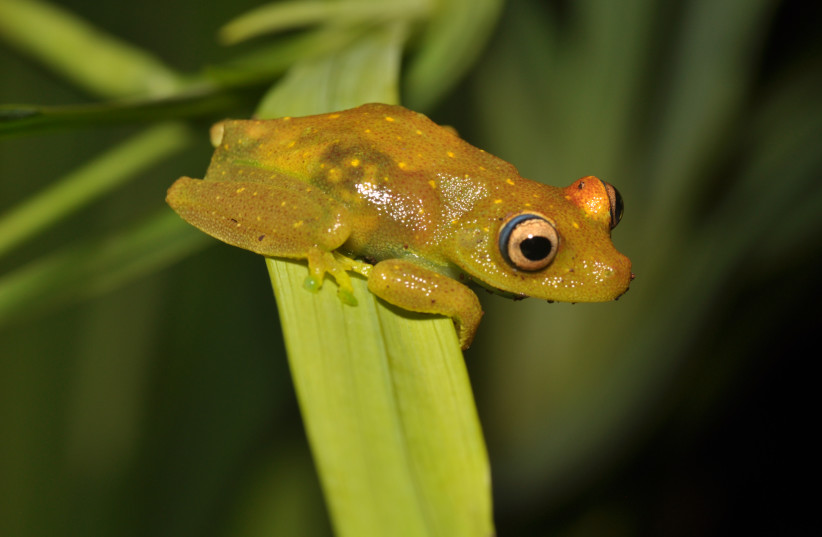Rabbits do not make a sound, and giraffes do not either, at least one that humans can hear. Other creatures like coyotes, elks, ravens, geese, donkeys, and turkeys. cougars, barn owls, and bobcats can all make a noise like a shriek – and male red foxes are found like screaming woman to scare away competing males.
Now, for the first time in South America, researchers have recorded the use of ultrasound by a frog endemic to the Atlantic Rainforest in Brazil, which has more species of amphibians than any other country.
The study just reported in the journal Acta Ethologica under the title “Ultrasonic distress calls and associated defensive behaviors in Neotropical frogs” describes the first documented case of the use of ultrasound for defense against predators, in a distress call of ear-piercing intensity to many animals but inaudible to humans.
“Some potential predators of amphibians such as bats, rodents, and small primates can emit and hear sounds at this frequency that humans can’t,” said Ubiratã Ferreira Souza, first author of the article. The study was part of his master’s research at the State University of Campinas’s Institute of Biology in São Paulo state, Brazil. “One of our hypotheses is that the distress call is addressed to some of these, but it could also be the case that the broad frequency band is generalist in the sense that it’s supposed to scare as many predators as possible.”
Another hypothesis is that the scream is meant to attract another animal to attack the predator that is threatening the amphibian, in this case, the leaf litter frog (Haddadus binotatus,) a species endemic to the Brazilian Atlantic Rainforest.

The researchers recorded the distress call on two occasions. When they analyzed the sound using special software, they found that it had a frequency range of seven to 44 kilohertz (kHz). Humans cannot hear frequencies higher than 20 kHz, which are classed as ultrasound.
Frog's ultrasound defense call
While emitting its distress call, this frog makes a series of movements typical of defense against predators. It raises the front of its body, opens its mouth wide, and jerks its head backward. It then partially closes its mouth and emits a call that ranges from a frequency band audible to humans to an inaudible ultrasound band.
“In light of the fact that amphibian diversity in Brazil is the highest in the world, with more than 2,000 species described, it wouldn’t be surprising to find that other frogs also emit sounds at these frequencies,” said doctoral student Mariana Retuci Pontes, a co-author of the article.
The use of this strategy by another species may have been accidentally discovered by Pontes herself. In January 2023, during a visit to the Upper Ribeira State Tourism Park in Iporanga, São Paulo state, she saw on a rock an animal that was probably a Hensel’s big-headed frog (Ischnocnema henselii,) although she did not collect the animal to identify the species precisely.
Holding the frog by the legs to try to take a photo, she was surprised to find that its defensive movement and distress call closely resembled those of H. binotatus. A lancehead pit viper (Bothrops jararaca) was a few meters away, apparently confirming the hypothesis that this behavior is a response to predators.
She was able to record a video but could not analyze the soundtrack to confirm the presence of the ultrasound frequency band. Taking hold of a frog’s legs is a move typically used by researchers to simulate an attack by a predator.
“Both species live in leaf litter, are similar in size – between three and six centimeters – and have similar predators, so it’s possible that I. henselii also uses this distress call with ultrasound to defend itself against natural enemies,” said Prof. Luís Felipe Toledo, last author of the article.
There are also recordings of ultrasound calls by three Asian amphibian species, but the frequencies concerned are used for communication among individuals of the same species. In mammals, ultrasound use is common among whales, bats, rodents, and small primates. Its use by amphibians for self-defense against predators was unknown until Souza’s study.
The researchers now plan to address several questions raised by the discovery, such as which predators are sensitive to the distress call, how they react to it, and whether the call is intended to scare them or to attract their natural enemies. “Could the call be meant to attract an owl that will attack a snake that’s about to eat the frog?” Souza wondered.
